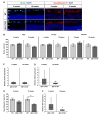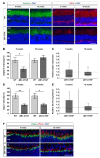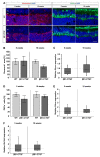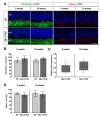Activation of Apoptosis in a βB1-CTGF Transgenic Mouse Model
- PMID: 33671472
- PMCID: PMC7922353
- DOI: 10.3390/ijms22041997
Activation of Apoptosis in a βB1-CTGF Transgenic Mouse Model
Abstract
To reveal the pathomechanisms of glaucoma, a common cause of blindness, suitable animal models are needed. As previously shown, retinal ganglion cell and optic nerve degeneration occur in βB1-CTGF mice. Here, we aimed to determine possible apoptotic mechanisms and degeneration of different retinal cells. Hence, retinae were processed for immunohistology (n = 5-9/group) and quantitative real-time PCR analysis (n = 5-7/group) in 5- and 10-week-old βB1-CTGF and wildtype controls. We noted significantly more cleaved caspase 3+ cells in βB1-CTGF retinae at 5 (p = 0.005) and 10 weeks (p = 0.02), and a significant upregulation of Casp3 and Bax/Bcl2 mRNA levels (p < 0.05). Furthermore, more terminal deoxynucleotidyl transferase-mediated dUTP nick end labeling (TUNEL+) cells were detected in transgenic mice at 5 (p = 0.03) and 10 weeks (p = 0.02). Neurofilament H staining (p = 0.01) as well as Nefh (p = 0.02) and Tubb3 (p = 0.009) mRNA levels were significantly decreased at 10 weeks. GABAergic synapse intensity was lower at 5 weeks, while no alterations were noted at 10 weeks. The glutamatergic synapse intensity was decreased at 5 (p = 0.007) and 10 weeks (p = 0.01). No changes were observed for bipolar cells, photoreceptors, and macroglia. We conclude that apoptotic processes and synapse loss precede neuronal death in this model. This slow progression rate makes the βB1-CTGF mice a suitable model to study primary open-angle glaucoma.
Keywords: Bax/Bcl2; apoptosis; caspase 3; neurofilament H; primary open-angle glaucoma; synapse; βB1-CTGF.
Conflict of interest statement
The authors declare no conflict of interest.
Figures






Similar articles
-
Cytokine and Complement Response in the Glaucomatous βB1-CTGF Mouse Model.Front Cell Neurosci. 2021 Nov 18;15:718087. doi: 10.3389/fncel.2021.718087. eCollection 2021. Front Cell Neurosci. 2021. PMID: 34867198 Free PMC article.
-
Loss of retinal ganglion cells in a new genetic mouse model for primary open-angle glaucoma.J Cell Mol Med. 2019 Aug;23(8):5497-5507. doi: 10.1111/jcmm.14433. Epub 2019 May 29. J Cell Mol Med. 2019. PMID: 31144440 Free PMC article.
-
Enhanced glaucomatous damage accompanied by glial response in a new multifactorial mouse model.Front Immunol. 2023 Jan 17;13:1017076. doi: 10.3389/fimmu.2022.1017076. eCollection 2022. Front Immunol. 2023. PMID: 36733392 Free PMC article.
-
Functional changes in inner retinal neurons in animal models of photoreceptor degeneration.Adv Exp Med Biol. 2010;664:525-32. doi: 10.1007/978-1-4419-1399-9_60. Adv Exp Med Biol. 2010. PMID: 20238055 Review.
-
BAX to basics: How the BCL2 gene family controls the death of retinal ganglion cells.Prog Retin Eye Res. 2017 Mar;57:1-25. doi: 10.1016/j.preteyeres.2017.01.002. Epub 2017 Jan 4. Prog Retin Eye Res. 2017. PMID: 28064040 Free PMC article. Review.
Cited by
-
Anti-CTGF/PD-1 bispecific antibody Y126S restrains desmoplastic and immunosuppressive microenvironment in pancreatic cancer.J Immunother Cancer. 2025 Jun 13;13(6):e012144. doi: 10.1136/jitc-2025-012144. J Immunother Cancer. 2025. PMID: 40514068 Free PMC article.
-
In a novel autoimmune and high-pressure glaucoma model a complex immune response is induced.Front Immunol. 2024 Mar 7;15:1296178. doi: 10.3389/fimmu.2024.1296178. eCollection 2024. Front Immunol. 2024. PMID: 38515755 Free PMC article.
-
Retinal debris triggers cytotoxic damage in cocultivated primary porcine RPE cells.Front Neurosci. 2024 Jul 24;18:1401571. doi: 10.3389/fnins.2024.1401571. eCollection 2024. Front Neurosci. 2024. PMID: 39114482 Free PMC article.
-
Progressive Retinal and Optic Nerve Damage in a Mouse Model of Spontaneous Opticospinal Encephalomyelitis.Front Immunol. 2022 Jan 24;12:759389. doi: 10.3389/fimmu.2021.759389. eCollection 2021. Front Immunol. 2022. PMID: 35140707 Free PMC article.
-
Cytokine and Complement Response in the Glaucomatous βB1-CTGF Mouse Model.Front Cell Neurosci. 2021 Nov 18;15:718087. doi: 10.3389/fncel.2021.718087. eCollection 2021. Front Cell Neurosci. 2021. PMID: 34867198 Free PMC article.
References
-
- Flaxman S.R., Bourne R.R.A., Resnikoff S., Ackland P., Braithwaite T., Cicinelli M.V., Das A., Jonas J.B., Keeffe J., Kempen J.H., et al. Global causes of blindness and distance vision impairment 1990–2020: A systematic review and meta-analysis. Lancet Global Health. 2017;5:e1221–e1234. doi: 10.1016/S2214-109X(17)30393-5. - DOI - PubMed
-
- Kerrigan-Baumrind L.A., Quigley H.A., Pease M.E., Kerrigan D.F., Mitchell R.S. Number of ganglion cells in glaucoma eyes compared with threshold visual field tests in the same persons. Invest. Ophthalmol. Vis. Sci. 2000;41:741–748. - PubMed
MeSH terms
Substances
Grants and funding
LinkOut - more resources
Full Text Sources
Other Literature Sources
Research Materials
Miscellaneous

